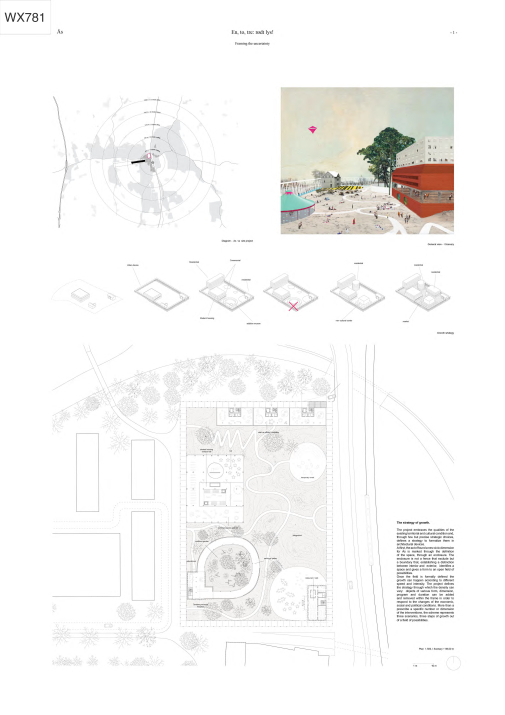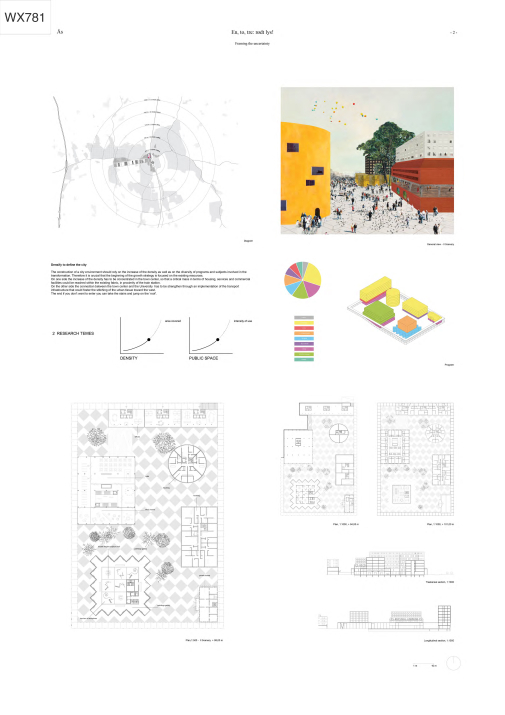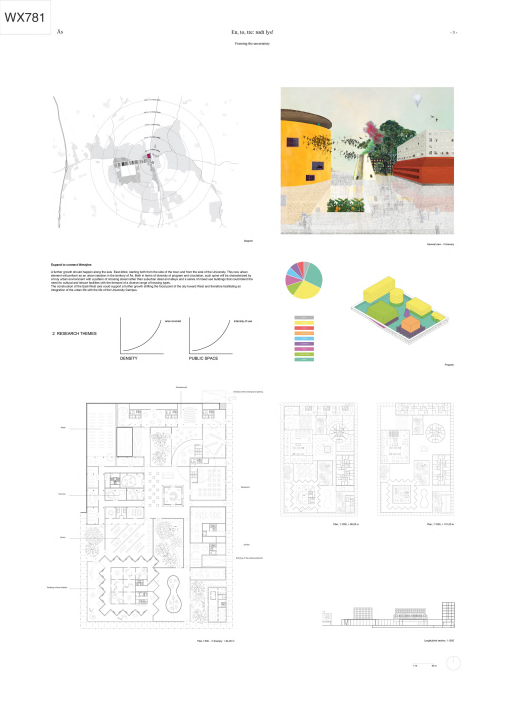Project:
En, To, Tre...Rødt Lys!
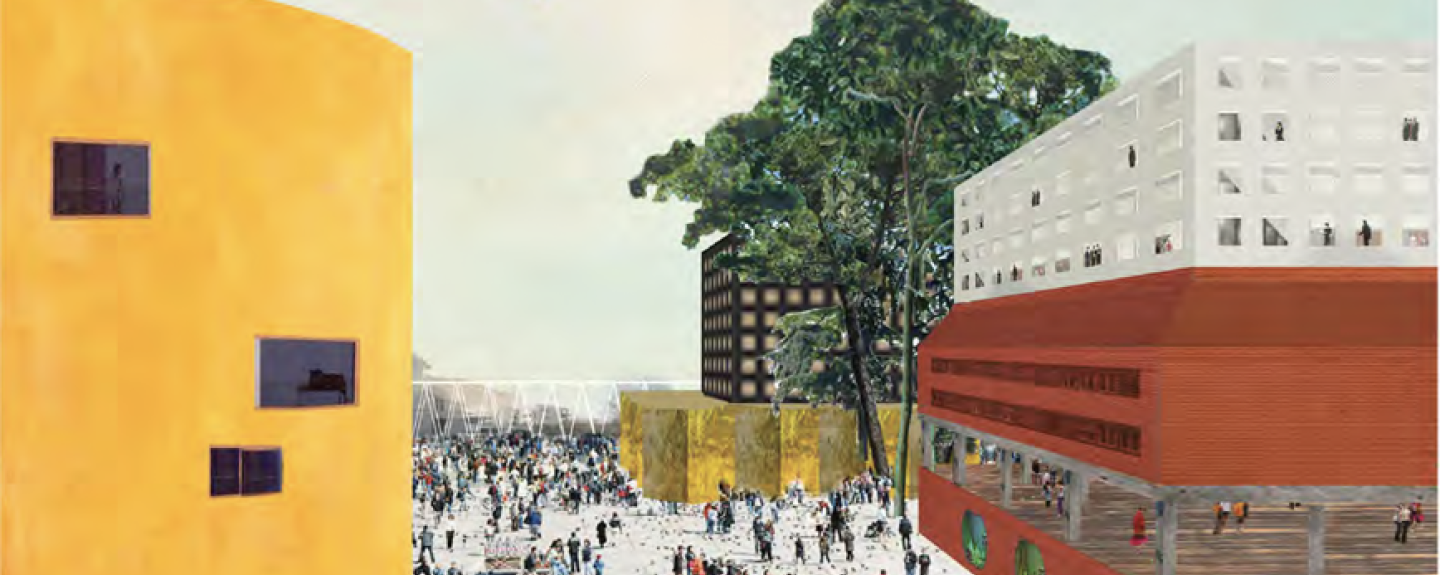
About
-
Architecture And The Open Field Of Possibilities
The growth of the Oslo region is activating energies and hopes as well as uncertainty and concerns regarding a transformation that seems radical and inevitable. The ever-changeing nature of the contemporary condition demands the elaboration of a strategy that could direct the urban development and all together accommodate unpredictable changes.
The proposal “En, to, tre...rødt lys!” is based on the conviction that architecture can frame changes through space and over time: rather than being subjected to the volatile desires of the market, architecture can be used as de- vice to define an open field of possibilities.
Ås Territory As Objects On The Field.
The territory of Ås is defined by a peculiar relationship between nature, agricultural land- scape and urbanization where architectural artifacts are singular objects lying on a continuous open filed. Going beyond the generic definition of sprawl we consider such condition as the spatial result of a specific way to inhabit the territory, where the relationship with the landscape has both a productive and a spiritual dimension. The project embraces the qualities of the existing territorial and cultural conditions and defines a strategy to formalize them into architectural devices.
A New Civic Dimension And The Strategy Of Growth.
The act of founding a new civic dimension for Ås is marked through the definition of the space, through an enclosure. The enclosure is not a fence that exclude but a boundary that, establishing a distinction between interior and exterior, identifies a space, giving a coherent frame to different possible speed and intensity of the development. The project defines therefore the strategy through which the density can vary within the enclosure without prescribing the quantity, the type and dimension of the interventions, but rather presenting three possible scenarios, three steps of the growth out of a field of possibilities. Densify to define the city on the urban level the project proposes to strategically focus on the existing resources, ostering the diversity of programs and subjects involved in the transformation and concentrating the density increase in the town center. At the same time the connection be- tween the town center and the University has to be strengthen stitching of the urban tissue toward the west. On the site scale, the inser- tion of the enclosure frames the field of a civic urban arena, allowing the transformation of existing buildings. A key role is played by the Mega, a “city lab” where urban activities could be tested to be then spread out in the city. We imagine the open space as a beach, a place where all men are equal, where the political debate to constitute the future of Ås can take place and form.
Expand To Connect Lifestyles
A further growth should be directed along the axis East-West as an urban injection in the territory of Ås. shifting the focal point of the city toward West and therefore facilitating the integration of city and campus life. The site will further develop, increasing its density in terms of both building mass and activities. The Tandberg estate could become an entirely new building for exhibition, workshops and learning activities replacing the old house. New buildings are imagined to increase significantly the density of the site while the open space should become a proper civic square that could combine a representative character with a degree of flexibility.
City Form To Preserve The Fields
A further development could be imagined around the voids where the agricultural land is already surrounded by the urban fabric. We propose to rigorously preserved the rural productive landscape, with “agricultural court- yards”, wide cultivated space on the scale of the urban fabric that will open a productive dialogue between the urban and the rural life. At the site level the enclosure will perform as an urban device capable to manage the urban circulation, a portico that will give an intense specific form to the urban environment. A glazed platform will flood the open space melting it into a kaleidoscopic interior field of activities defined by the enclosure as limit and the roof as horizon from which the distinct volumes will still emerge as islands of an archipelago.
-
This entry is an intelligent approach to a complex site. The proposal has managed on the one hand to create a frame for the development and on the other hand it shows aware- ness that urban planning today is not about designing and controlling but about reacting and adapting to the unpredictable future. This is materialized with a literal ‘frame’ construction that ‘will embrace an open field of possibilities’. This strong gesture of ‘framing’ creates a new civic dimension and identifies the space of the future development. The frame idea contains also poetic interpretations reminding to the concept of paradise, a fenced garden.
The project proposes a development in phases. The first phase of the proposal integrates the existing buildings that might be altered in order to incorporate new additions. The jury found it very positive that the plan can deal with the existing buildings of the area. After this, two more steps are described as pos- sible future scenarios, with different levels of density transforming the site eventually into a covered space with some open air patios.
At the larger scale the project answers in a logical way, reinforcing first the city centre to make use of the existing resources and the proximity to the station. The link with the university is first materialized with an improved system of public transportation and in future phases with the progressing densification of this east-west axis, all with a careful preservation of agricultural areas, what the designer describes as ‘agricultural courtyards’.
Although the plan argues that in Ås there is a tradition of ‘object placed in the landscape’ and uses this logic to position the new buildings in the framed ‘field of possibilities’, the project lacks a deeper reflection of the structure and character of the public space, that appears as the room left out by the buildings. The project could also elaborate more in the different functioning in summer and winter.
In general, in spite of these points that the Jury finds easy to accomplish in future development, the project makes a very interesting 1st prize for Ås. It shows a good understanding of the conditions, the context, the program and it is also able adapt and evolve during the development process while keeping its strength and character.
-
Team Representative: Luca Moscelli (IT) – architect; Associate: Angelo Renna (IT), Davide Sacconi (IT) – architects
Contributor: Raffaele Patitucci (IT) – architect urbanistUGO | Architecture and urban design, ‘s-Gravendijkwal 125C, 3021EK Rotterdam – Nederland
+31 6 39572859 – mail@office-ugo.com – www.office-ugo.com
L. Moscelli, A. Renna and D. Sacconi
Team interview
1. How did you form the team for the competition?
UGO came out of the desire to combine our experiences in international leading offices such as MVRDV and Stefano Boeri Architetti with the research trajectories we developed in our academic activity at the Politecnico of Milan, Berlage Institute and Bartlett School of Architecture.
UGO is a critical project on the inevitable changes of reality, a strategic approach to urbanization, a tactical use of spatial devices for the construction of the city. It arose from the collaboration of the three of us with the idea to explore the potential of architecture in framing urban transformations through space and over time.
2. How do you define the main issue of your project, insisting on how you answered on this session main topic: adaptability and urban rhythms?
Our project takes on the ever-changing nature of the contemporary condition through a strategic approach to urban design and a tactical use of architecture. The massive and fast growth of the Oslo region is activating energies and hopes as well as uncertainty and concerns regarding a transformation that seems radical and inevitable. This delicate moment of transition demands the elaboration of a strategy that could direct the urban development while at the same time being open to accommodate unpredictable changes. We believe architecture can frame changes through space and over time: rather than being subjected to the volatile desires of the market, architecture can be used as a device to define an open field of possibilities
3. How did this issue and the questions raised by the site mutation meet?
With a forecasted doubling of the population, Ås is expecting a substantial transformation: from a rural village to a town that would be an active part of the urban constellation of Oslo. At the same time the territory of Ås is the spatial result of a specific way to inhabit where the relationship between nature, agricultural landscape and urbanization manifests itself as objects lying on a continuous filed.
The project embraces the qualities of such territorial and cultural condition defining a strategy to accommodate the growth in time through means of architecture.
Enclosing the site through a portico the project marks the foundation of a new civic dimension for Ås. The enclosure is not a fence that excludes, but a boundary that, establishing a distinction between interior and exterior, identifies a space and gives a form to the field of possibilities, therefore allowing different development speed and intensity to happen within a coherent frame.
The density can vary within the frame: objects of various form, dimension, program and duration can be added and removed in order to respond to the changes of the economic, social and political conditions. More than prescribe the quantity, the type and dimension of interventions, the scheme presents three possible scenarios, three steps of the growth out of a field of possibilities.

4. Have you already treated this issue previously and could you present some reference projects that inspired yours?
The issues of the relationship between architecture and urban design vis-à-vis the uncertainty of the contemporary condition is a central theme in our projects. For example the Tablature project, developed at the Berlage Institute and published in Domus 962, proposes a strategy to act within the economic and urban crisis of Athens with an architecture that would challenge the relationship between the private and public sphere both on a spatial level and on the level of the economic and legal protocols. The project Cactus Madre, published in Casabella 813, reflects on the idea of infrastructure, public space and territory consumption through the elaboration of a vertical model of urbanization for a non-anthropocentric humanity where the man doesn’t any longer dominate all cultures but is part of a new circle of the world. Another example is the multi-scale project Begato 9, published in Abitare, that turns a controversial case of social housing into an inhabited landmark in the landscape, going beyond the conventional idea of demolition as formal and normative criteria.
In our Europan project we propose to use architecture as strategic device to frame uncertainties and changes through space and throughout time. Therefore, we looked at some historical examples of how the architecture itself, in its bare form rather than in its program, was able to give quality and resilience to the city. For example, the Segovia aqueduct (ES) has lost its primary function but still informs the character of the public space with its monumentality; in the Piazza Navona, in Rome (IT), the form of a stadium has persisted through the medieval abandonment becoming a baroque square even resisting the radical experiments of Superstudio; in the Bankside Power Station (UK), the internal space preserves its spectacular dignity from its day as a turbine hall having become a space for art installations.
In conclusion we found inspiration in architecture that offers resistance and meaning to change.
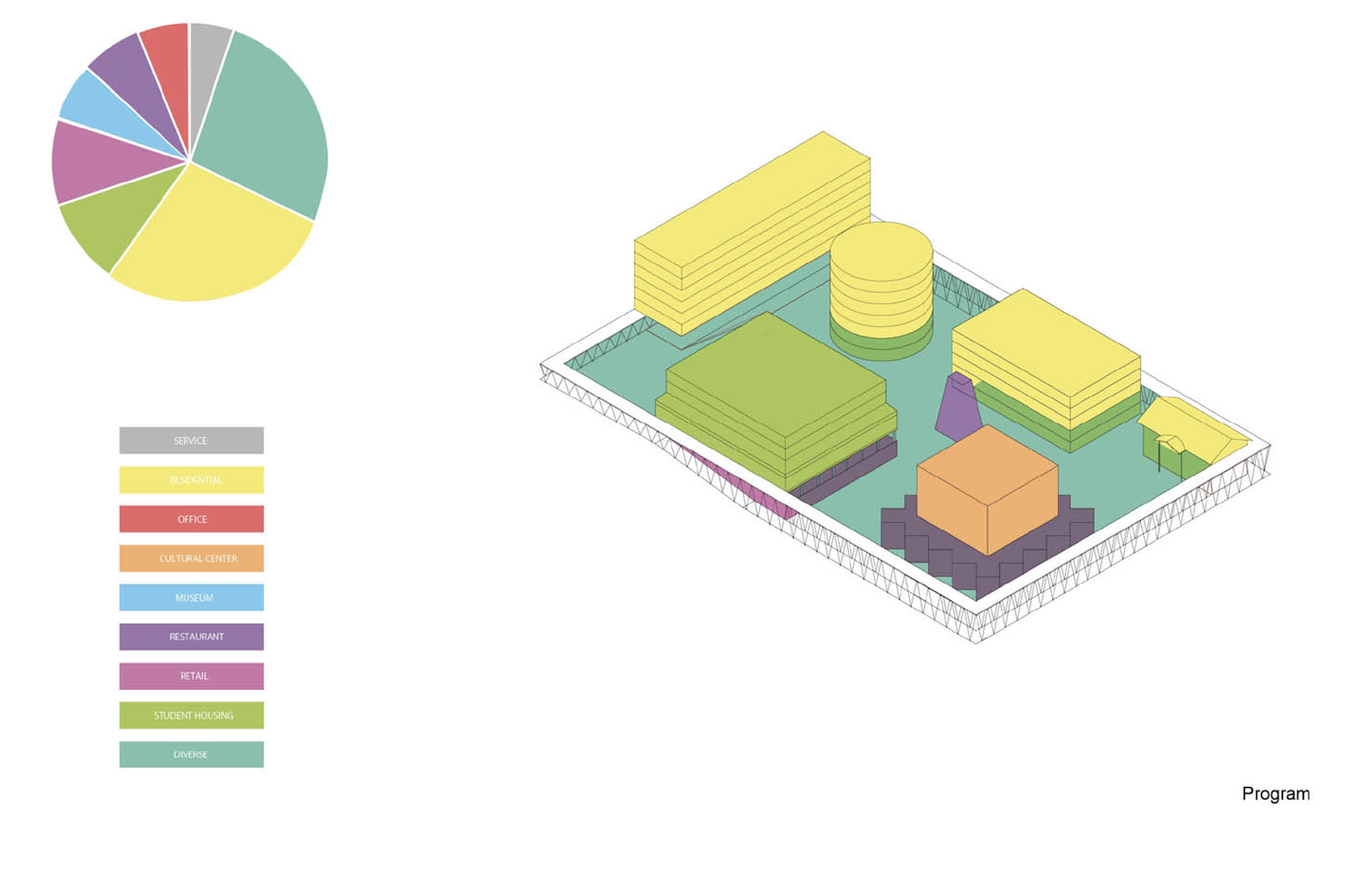
5. Today –within the era of an economic crisis and sustainability– the urban-architectural project should reconsider its production method in time; how did you integrate this issue in your project?
The issue of time is not just integrated, is the very core of our design approach. In the equilibrium between accommodate and direct changes lies the true potential of architecture: going beyond instrumentality, the inevitable slowness and materiality of architecture can offer a resistance to the continuous flows urbanization and financial capitalism giving back dignity to urban life.
6. Is it the first time you have been awarded a prize at Europan? How could this help you in your professional career?
It is the first time we have won a Europan competition. We believe Europan is a great chance to develop projects from the conceptual level down to the construction site in a process that in Ås involves the municipality as well as the university and private developers. We are looking forward to the further implementation of the project.
Related projects
-

En, To, Tre...Rødt Lys!
Rather than being subjected to the volatile desires of the market, architecture can be used as…
-
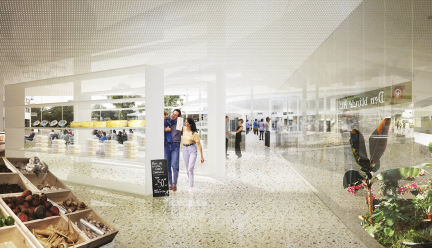
All eyes on Ås
The planning vision for Ås future cannot miss the call to integrate and interbreed the city life…
-
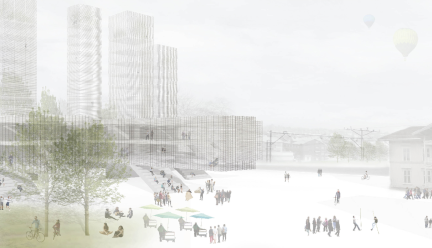
Straight Line
Our scope has its roots in a clear and simple idea; city building is based on the public realm, and…
